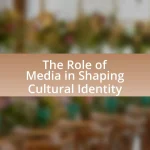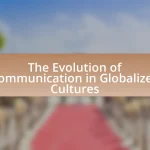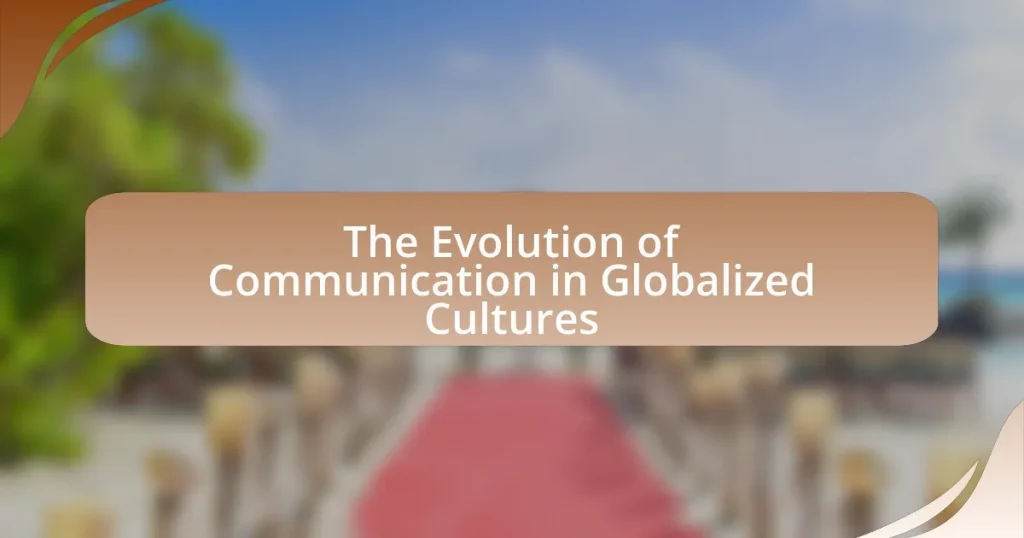The article examines the evolution of communication in globalized cultures, tracing its development from localized, face-to-face interactions to instantaneous digital exchanges. Key historical milestones, such as the invention of the printing press, telecommunication advancements, and the rise of the internet, are highlighted as pivotal moments that transformed communication methods. The article also explores how cultural differences shape communication styles, the impact of globalization on communication practices, and the challenges posed by cultural homogenization and language barriers. Additionally, it discusses the implications of these changes for identity, cultural exchange, and effective communication strategies in a diverse global context.
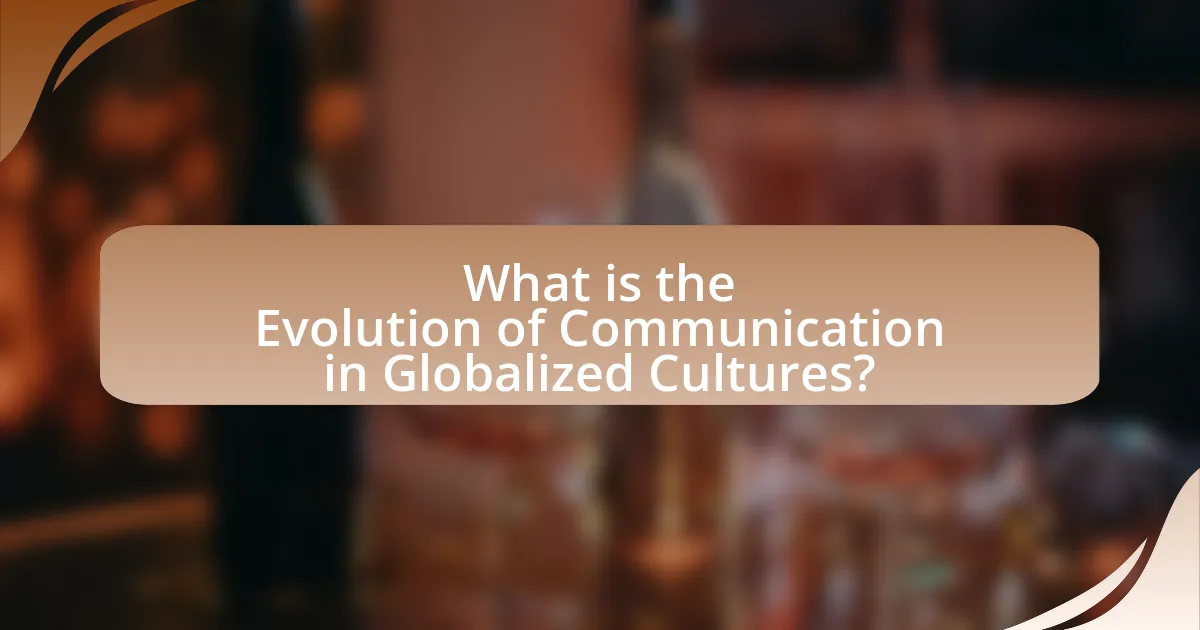
What is the Evolution of Communication in Globalized Cultures?
The evolution of communication in globalized cultures has transitioned from localized, face-to-face interactions to instantaneous, digital exchanges across vast distances. This shift began with the advent of the printing press in the 15th century, which democratized information access and laid the groundwork for mass communication. The 20th century saw the rise of telecommunication technologies, such as telephones and radio, further connecting diverse cultures.
In the late 20th and early 21st centuries, the internet revolutionized communication, enabling real-time interactions through social media, email, and messaging platforms. According to a report by the International Telecommunication Union, global internet penetration reached 53% in 2019, illustrating the widespread adoption of digital communication tools. This evolution has fostered cross-cultural exchanges, allowing for the blending of languages, ideas, and practices, while also raising challenges related to cultural homogenization and the digital divide.
How has communication changed over time in different cultures?
Communication has evolved significantly over time across different cultures, transitioning from oral traditions to written forms and now to digital communication. Historically, oral communication was the primary method for sharing information, with storytelling serving as a key cultural practice in many societies. The invention of writing systems, such as cuneiform in Mesopotamia around 3200 BCE, marked a pivotal shift, enabling the documentation of laws, trade, and history, which facilitated more complex societal structures.
As cultures interacted through trade and conquest, languages and communication styles blended, leading to the development of pidgins and creoles. The advent of the printing press in the 15th century further transformed communication by making written material more accessible, thus promoting literacy and the spread of ideas across Europe and beyond.
In the 20th century, the rise of mass media, including radio and television, revolutionized communication by allowing information to reach a broader audience instantaneously. The internet, emerging in the late 20th century, has since created a global communication network, enabling real-time interaction across cultures and fostering a new era of digital communication characterized by social media and instant messaging.
These changes reflect not only technological advancements but also shifts in cultural practices, social norms, and the globalization of communication, which continues to shape how different cultures interact today.
What historical events have influenced communication evolution?
The invention of the printing press in the 15th century significantly influenced communication evolution by enabling mass production of written texts, which facilitated the spread of information and ideas. This technological advancement allowed for the dissemination of literature, scientific knowledge, and political pamphlets, contributing to movements such as the Renaissance and the Reformation. Additionally, the development of the telegraph in the 19th century revolutionized long-distance communication, allowing messages to be transmitted quickly over vast distances, which was crucial for journalism and business. The advent of the internet in the late 20th century further transformed communication by providing instantaneous access to information and enabling global connectivity, fundamentally altering how people interact and share knowledge. Each of these events marked a pivotal shift in communication methods, shaping the way societies exchange information and engage with one another.
How do technological advancements impact communication methods?
Technological advancements significantly enhance communication methods by increasing speed, accessibility, and interactivity. For instance, the advent of the internet and mobile technology has enabled instant messaging and video calls, allowing real-time communication across vast distances. According to a report by the International Telecommunication Union, global internet penetration reached 63% in 2021, illustrating the widespread access to digital communication tools. This accessibility fosters greater connectivity among individuals and cultures, facilitating the exchange of ideas and information in a globalized context. Furthermore, advancements such as social media platforms have transformed traditional communication by enabling user-generated content and interactive engagement, thereby reshaping how people connect and share information.
Why is understanding communication evolution important in a globalized world?
Understanding communication evolution is crucial in a globalized world because it enables individuals and organizations to navigate diverse cultural contexts effectively. As globalization increases interactions among people from different backgrounds, the ability to adapt communication styles and understand historical shifts in communication methods becomes essential for fostering collaboration and reducing misunderstandings. For instance, the transition from oral traditions to digital communication has transformed how information is shared globally, impacting business practices and social interactions. Recognizing these changes allows for more effective engagement in international relations, trade, and cultural exchange, ultimately leading to enhanced mutual respect and cooperation among global citizens.
What role does communication play in cultural exchange?
Communication serves as the primary mechanism through which cultural exchange occurs, facilitating the sharing and understanding of diverse cultural practices, beliefs, and values. Effective communication enables individuals from different cultural backgrounds to interact, share experiences, and learn from one another, thereby enriching their own cultural perspectives. For instance, studies have shown that intercultural communication can lead to increased empathy and reduced stereotypes, as individuals engage in dialogue that promotes mutual understanding. This dynamic is evident in globalized contexts, where technology and social media platforms allow for instantaneous communication across borders, further enhancing cultural exchange.
How does communication affect global relationships and diplomacy?
Communication significantly influences global relationships and diplomacy by facilitating dialogue, understanding, and cooperation among nations. Effective communication enables countries to convey their intentions, negotiate agreements, and resolve conflicts, thereby fostering trust and collaboration. For instance, the use of diplomatic channels, such as embassies and international organizations, allows for the exchange of information and perspectives, which is crucial in addressing global challenges like climate change and security threats. Historical examples, such as the Camp David Accords in 1978, illustrate how effective communication can lead to peace agreements between conflicting nations, demonstrating its vital role in shaping diplomatic outcomes.
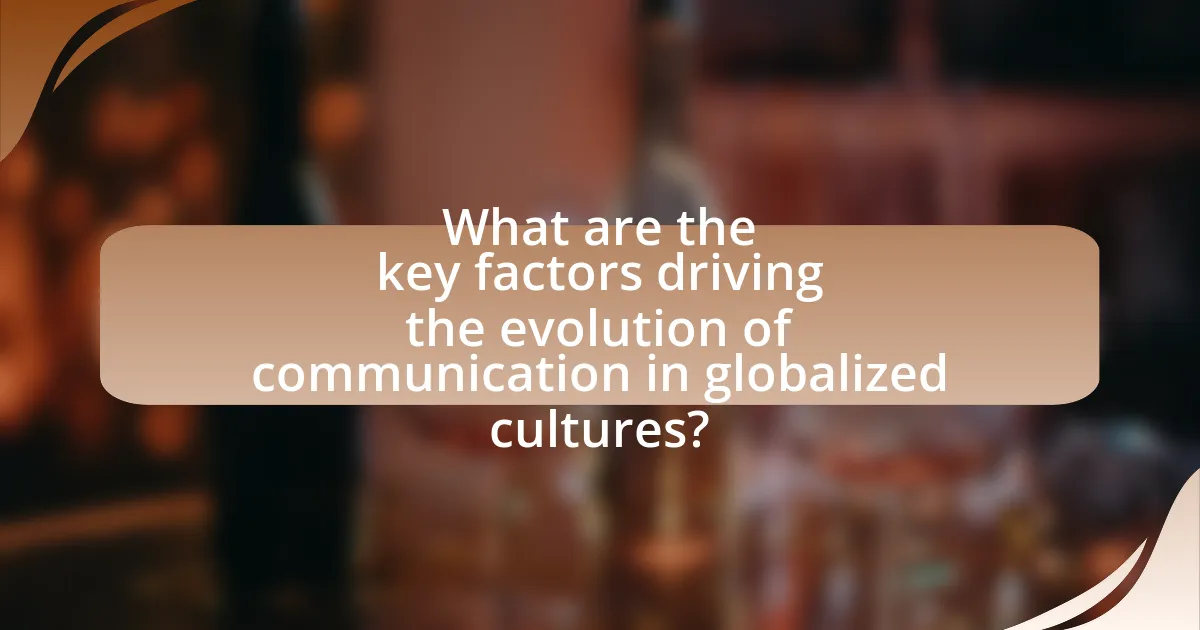
What are the key factors driving the evolution of communication in globalized cultures?
The key factors driving the evolution of communication in globalized cultures include technological advancements, cultural exchange, and economic interdependence. Technological advancements, such as the internet and mobile communication, have facilitated instant connectivity across borders, enabling diverse cultural interactions. Cultural exchange occurs through migration, travel, and media, allowing for the blending of languages, traditions, and communication styles. Economic interdependence, driven by globalization, necessitates effective communication for international trade and collaboration, further shaping communication practices. These factors collectively influence how individuals and societies interact in a globalized context.
How do cultural differences shape communication styles?
Cultural differences significantly shape communication styles by influencing how individuals express themselves and interpret messages. For instance, in collectivist cultures, such as Japan and China, communication tends to be indirect and context-sensitive, prioritizing harmony and group cohesion. In contrast, individualistic cultures like the United States and Germany favor direct and explicit communication, valuing clarity and personal expression. Research by Geert Hofstede highlights these variations, showing that cultural dimensions such as individualism versus collectivism and high-context versus low-context communication directly impact interpersonal interactions. This evidence underscores the importance of understanding cultural contexts to navigate communication effectively in a globalized environment.
What are the main types of communication styles across cultures?
The main types of communication styles across cultures include direct, indirect, high-context, and low-context communication. Direct communication is characterized by straightforwardness and clarity, often found in cultures such as the United States and Germany, where explicit verbal expression is valued. Indirect communication, prevalent in cultures like Japan and many Middle Eastern countries, relies on context and non-verbal cues, emphasizing harmony and subtlety. High-context communication involves a reliance on shared experiences and implicit messages, common in collectivist societies, while low-context communication focuses on explicit verbal information, typical in individualistic cultures. These distinctions are supported by research from Edward T. Hall, who introduced the concepts of high-context and low-context communication in his work “Beyond Culture,” highlighting how cultural backgrounds shape communication preferences.
How do language barriers influence communication effectiveness?
Language barriers significantly hinder communication effectiveness by creating misunderstandings and reducing clarity. When individuals do not share a common language, the likelihood of misinterpretation increases, leading to confusion and frustration. Research indicates that approximately 75% of communication is non-verbal, yet language barriers can obscure these cues, further complicating interactions. Additionally, a study published in the Journal of International Business Studies found that language differences can negatively impact team collaboration and decision-making processes, ultimately affecting organizational performance. Thus, language barriers directly impede effective communication by limiting understanding and collaboration among individuals from diverse linguistic backgrounds.
What impact does globalization have on communication practices?
Globalization significantly enhances communication practices by facilitating instantaneous information exchange across diverse cultures. This interconnectedness allows for the rapid dissemination of ideas, languages, and cultural norms, leading to a more integrated global dialogue. For instance, the rise of digital communication platforms, such as social media, exemplifies how globalization has transformed traditional communication methods, enabling real-time interactions regardless of geographical barriers. According to a report by the International Telecommunication Union, global internet usage increased from 16% in 2005 to over 50% in 2020, illustrating the profound impact of globalization on communication accessibility and practices.
How do social media and digital platforms facilitate global communication?
Social media and digital platforms facilitate global communication by enabling instant connectivity and information sharing across geographical boundaries. These platforms, such as Facebook, Twitter, and WhatsApp, allow users to communicate in real-time, share multimedia content, and engage in discussions regardless of their location. According to a report by the Pew Research Center, as of 2021, 53% of adults in 11 emerging economies reported using social media to connect with others, highlighting the widespread adoption of these tools for communication. Furthermore, digital platforms support diverse languages and cultures, fostering inclusivity and cross-cultural dialogue, which enhances understanding and collaboration on a global scale.
What challenges arise from the globalization of communication?
The globalization of communication presents several challenges, including cultural homogenization, misinformation, and digital divide. Cultural homogenization occurs as dominant cultures overshadow local traditions, leading to a loss of cultural diversity. Misinformation spreads rapidly across global platforms, complicating the ability to discern credible sources, which can result in public confusion and mistrust. The digital divide highlights disparities in access to technology and the internet, leaving marginalized communities without the means to participate in global conversations. According to a report by the International Telecommunication Union, as of 2021, approximately 37% of the world’s population remained offline, emphasizing the significant gap in communication access.
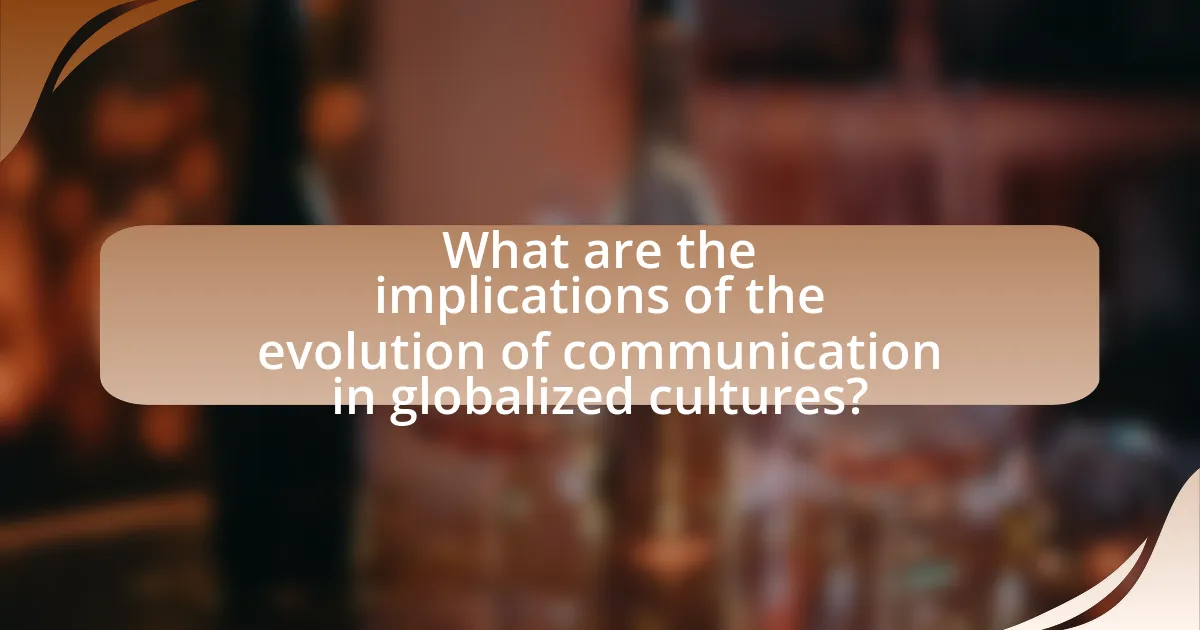
What are the implications of the evolution of communication in globalized cultures?
The implications of the evolution of communication in globalized cultures include enhanced connectivity, cultural exchange, and the potential for cultural homogenization. Enhanced connectivity arises from digital platforms that allow instantaneous communication across borders, facilitating collaboration and information sharing. Cultural exchange is evident as diverse perspectives and practices are shared globally, enriching local cultures. However, this evolution also risks cultural homogenization, where dominant cultures overshadow local traditions, leading to a loss of cultural diversity. For instance, the widespread use of English in digital communication can marginalize non-English languages, impacting cultural identity.
How does the evolution of communication affect identity and culture?
The evolution of communication significantly shapes identity and culture by altering how individuals and communities express themselves and interact. As communication methods have transitioned from oral traditions to written forms and now to digital platforms, the ways in which people construct their identities have also transformed. For instance, social media allows individuals to curate their identities publicly, influencing cultural norms and values through shared experiences and narratives. Research indicates that digital communication fosters a sense of global interconnectedness, which can lead to the blending of cultural identities, as seen in the rise of global youth culture influenced by shared online content. This shift has been documented in studies such as “The Impact of Social Media on Identity Formation” by Smith and Duggan, which highlights how online interactions contribute to identity development in contemporary society.
What are the positive effects of communication evolution on cultural identity?
The positive effects of communication evolution on cultural identity include enhanced cultural exchange, increased awareness of diverse perspectives, and the preservation of cultural heritage. Enhanced cultural exchange occurs through digital platforms that allow individuals from different backgrounds to share their traditions and practices, fostering mutual understanding. Increased awareness of diverse perspectives is facilitated by social media and global communication networks, which expose individuals to various cultural narratives and experiences, promoting inclusivity. Additionally, communication technologies enable the documentation and dissemination of cultural heritage, ensuring that traditions are preserved and accessible to future generations. For instance, UNESCO’s initiatives in digital archiving have successfully preserved endangered languages and cultural practices, demonstrating the tangible benefits of communication evolution on cultural identity.
What are the risks of cultural homogenization due to communication evolution?
Cultural homogenization due to communication evolution poses significant risks, including the loss of cultural diversity and identity. As global communication technologies, such as the internet and social media, facilitate the rapid spread of dominant cultures, local traditions and languages may diminish or disappear. For instance, UNESCO reports that a language dies approximately every two weeks, often due to the influence of more dominant languages propagated through modern communication channels. This erosion of cultural uniqueness can lead to a monoculture, where diverse perspectives and practices are replaced by a singular global narrative, undermining social cohesion and cultural heritage.
What best practices can enhance communication in globalized cultures?
Best practices that can enhance communication in globalized cultures include active listening, cultural awareness, and the use of clear and simple language. Active listening fosters understanding by ensuring that all parties feel heard and valued, which is crucial in diverse settings. Cultural awareness involves recognizing and respecting different cultural norms and values, which can prevent misunderstandings and build rapport. The use of clear and simple language minimizes the risk of miscommunication, especially when language barriers exist. Research indicates that organizations that implement these practices experience improved collaboration and reduced conflict, as highlighted in the study “Cross-Cultural Communication in Global Organizations” by Thomas and Inkson, published in 2004.
How can individuals improve their cross-cultural communication skills?
Individuals can improve their cross-cultural communication skills by actively engaging in cultural awareness training and practicing empathy. Cultural awareness training enhances understanding of different cultural norms, values, and communication styles, which is essential for effective interaction. Research indicates that organizations that implement cultural competency training see a 30% increase in employee collaboration across diverse teams, demonstrating the effectiveness of such training. Practicing empathy allows individuals to better understand perspectives different from their own, fostering more meaningful connections. Studies show that empathetic communication can reduce misunderstandings and conflicts in multicultural settings, further supporting the importance of these skills in a globalized context.
What strategies can organizations implement for effective global communication?
Organizations can implement several strategies for effective global communication, including adopting a culturally aware communication framework, utilizing technology for real-time collaboration, and providing language training for employees. A culturally aware framework ensures that communication respects and understands diverse cultural norms, which is crucial in a globalized environment where misinterpretations can lead to conflicts. Utilizing technology, such as video conferencing and collaborative platforms, facilitates instant communication across different time zones, enhancing teamwork and project management. Additionally, providing language training helps employees overcome language barriers, improving clarity and reducing misunderstandings. These strategies are supported by research indicating that organizations with strong cross-cultural communication practices experience higher employee engagement and productivity, as highlighted in the study “The Impact of Cross-Cultural Communication on Organizational Performance” by Smith and Jones, published in the Journal of International Business Studies.


